Cutlery
Cutlery
Before the 18th century the only items of table silver made in any quantity were spoons. Plates and knives were set on the table, food was cut with the knife and eaten with one’s personal spoon (or fingers). Silver forks were introduced from France in the mid 17th century but are rare prior to the 18th century. It is unusual to find sets of table silver dating earlier than the late 18th century.
The hallmarks on pre 1780 table silver are often squashed and distorted. At that time the silver marks used to be struck on the thin part of the stem which distorted the form of the piece and required the silversmith to hammer the piece back into shape. From c.1780 onwards the Assay Office stamped table silver near the top of the stem as opposed to on the stem just below the bowl, and hallmarks are generally much clearer because there is more space on which to strike them.
Canteens of Antique Silver Cutlery
Table silver was made in sets from circa 1690 onwards but did not come into popular use until the late 18th century when fashionable hosts started to lay their tables with a matching set of cutlery and flatware for their guests. Boxed sets were displayed on the sideboard and could be carried to other family residences. They became popular wedding presents when mass production made them affordable in the 1900s. Nowadays these complete sets of cutlery are generally sold without a fitted box or table. The word canteen remains in use describing an area for communal dining.
Mother of Pearl Cutlery
In the late 19th century sets of cutlery and serving pieces with real mother of pearl handles became popular. They are often found in their original fitted boxes and make attractive wedding gifts. Cutlery handles made from real mother of pearl shell occasionally have a slight variation in grain and size.
Knives – Silver Handled Knives, Skewers and Carving Sets. The word “cutlery” is used generically today to describe all knives, forks and spoons however it was originally used solely for knives and other related cutting instruments. The origin of the word “cutlery” comes from the old French word “coutelier. By the 18th century the provincial English town of Sheffield had become an international centre of the cutlery industry making knives with hollow silver handles that were stamped in two halves, soldered together and inserted with a steel knife blade. Nowadays the original steel blades are often replaced with stainless steel blades which are easier to maintain.
Spoons and Forks –
Collectors Spoons, Dinner, Soup and Dessert Spoons, Serving Spoons.
Tea, Coffee, Salt and Mustard Spoons
Caddy Spoons, Marrow Spoons, Mote Spoons
Before the 18th century the only items of table silver made in any quantity were spoons. Early English silver spoons can date from as early as the 15th century and are highly collectible, especially spoons by rare makers and from unusual provincial towns. The most popular form of cast terminal was the seal top spoon, named after the circular disc at the top, which often bore the engraved initials of the owners. Lion sejant spoons and apostle spoons were also common from the 15th century to the beginning of the 17th century. From the late 16th century the plain flattened stem of the slip top spoon was introduced which developed during the 17th century into the popular trefid form.
Forks. Silver Dinner and Dessert Forks are rare before the 18th century and are not often found in sets until the late 1700s.
The Sucket Fork is an implement with a teaspoon bowl at one end and a two pronged fork at the other. Very rare and only produced from the late 17th century until the early 18th century.
Serving Pieces –
Serving Spoons, Basting Spoons, Ladles,
Serving Slices, Asparagus Tongs, Grape Shears, Sugar Nips
As formal table silverware developed during the 18th century many different forms of serving pieces were introduced with very specific functions.
Long handled serving spoons have been in use since c.1680 and the early spoons had tubular handles. These are usually termed as basting or stuffing spoons; the earliest super large size is termed as a hash spoon
Punch ladles were introduced in the early 1700’s and differ from other ladles in the fact that they have turned wood or twisted whalebone handles. Originally they had round bowls which were superseded in about 1735 by egg shaped bowls. Later on lips were added and after 1760 they were often inset with silver coins.Silver soup and sauce ladles date from George II period and later.
The first fish slice, made in circa 1740, originally had a triangular blade and these are now highly sought after to serve cake and pastries.
Asparagus servers with a serrated blade and chop tongs date from the end of the 18th century.
Grape shears are not found until the 19th century. These are often in presentation boxes and can have beautiful grapevine decoration.
Caddy spoons for measuring out tea leaves were made from 1780 onwards.
-

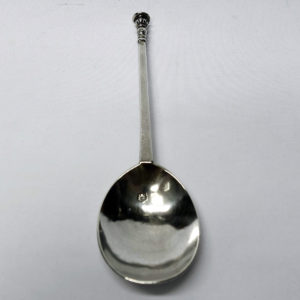
Circa 1661
Stephen Venables
9086 Antique Charles II Sealtop Silver Spoon
Sold
An early English period sterling silver spoon with a fig shape bowl and double baluster seal terminal. The seal end has the original gilt finish (worn) with prick dot initials “IW”. Initial “R” to the reverse of the bowl. Weight 42 grams, 1.3 troy ounce. Length 17.1cm. Bowl 6.5x5cm. London circa 1661. Maker Stephen Venables, a leading spoon maker of the period.
Table silver of this date was stamped with “up the handle” silver marks and it is not unusual that marks punched on the thin central part of the handle stamps are distorted or badly struck and difficult to read. -

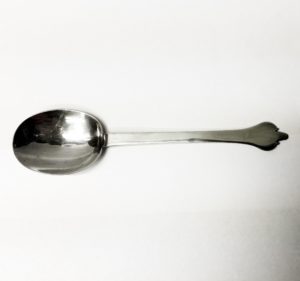
Circa 1680
8717 Antique Silver Trefid Spoon
Sold
A good antique sterling silver spoon with a trefid terminal and rat-tail bowl. Dessert size. The spoon has a very attractive hand hammered finish. Weight 36 grams, 1 troy ounces. Length 18.5 cms. Bowl 6×4.75 cms. Makers mark ‘TA’ within a shield. Circa 1700.
-

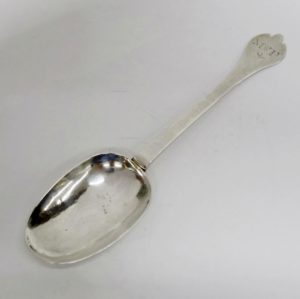
1689
9261 Antique Silver Trefid Spoon
Sold
A good antique sterling silver spoon, the oval bowl with incised and beaded rat tail heel, the flat stem with a trefid pattern terminal. William & Mary period. Hand hammered finish. Owners initials to the front and back. Weight 51 grams, 1.6 troy ounces. Length 20cm. Bowl 7×4.6cm. Makers mark ‘IL’ over a mullet, within a shield. London 1689.
-

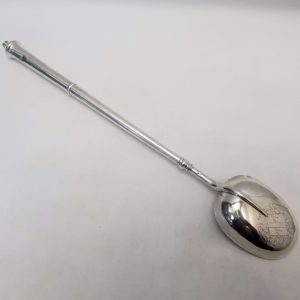
1697
William Fawdery
10235 William III Antique Silver Cannon Handle Spoon
Sold
A massive antique sterling silver hash spoon with the long tubular handle and a large deep bowl with a rattail extension to the underside. This elegant form is known as a Cannon handled spoon and can be used as a basting or stuffing spoon. Very useful size. To the reverse of the handle terminal there is an intricate hand engraved armorial. Weight 234 grams, 7.5 troy oz. Length 44.5cm. Bowl 10.4 x 7.5cm. London 1697. Maker probably William Fawdery. Britannia standard silver.
-

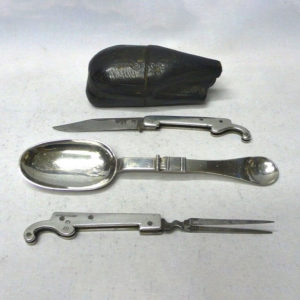
Circa 1700
8638 Antique German Silver Travelling Cutlery Set
Sold
A rare set of antique silver folding cutlery- knife, fork and spoon. All expertly made to be as compact as possible so that it all fits inside the original tooled leather carrying case. The knife and fork have steel blades. Each piece has silver hallmarks for Nurnberg circa 1700. Maker Christoph Hieronymous Clauss.
-

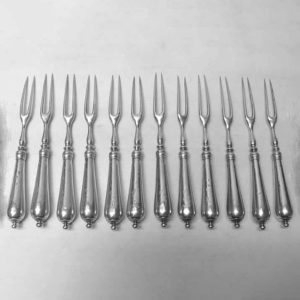
Circa 1700
7548 Antique William III Silver Forks
Sold
A rare set of 12 early silver forks with cannon handles and twin prongs. Each hand engraved with a contemporary crest of a stork. Weight 465 grams, 15 troy ounces. Length 16 cms. Three are stamped with the makers mark of SE in an oval punch. Circa 1700.
-


1703
John Ladyman
8149 Queen Anne Silver Dog Nose Spoon
Sold
A good example of an antique silver dog nose spoon dating from the beginning of Queen Anne’s reign. Made of Britannia standard silver* and retaining the original gilt finish. The reverse of the bowl with a long rat-tail. The front of the terminal hand engraved with an armorial, the reverse of the terminal with the presentation date 12th October 1702. Weight 64 grams, 2 troy ounces. Length 20 cms. London 1703. Maker John Ladyman.
-

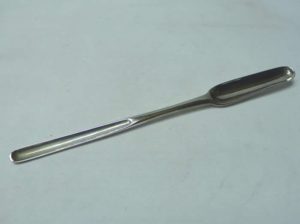
1707
Henry Greene
7413 Queen Anne Silver Marrow Scoop
Sold
An early English silver marrow scoop of plain design with an engraved monogram under the bowl. Britannia standard silver*. These scoops were used to remove the marrow from the bone at the dining table. Weight 43 grams, 1.3 troy ounces. London 1707. Maker Henry Green.
-

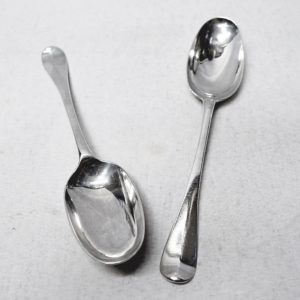
1712
Lawrence Jones
8799 Antique Queen Anne Silver Table Spoons
Sold
A pair of early English silver spoons in the popular Hanoverian rat-tail pattern. Lovely plain style. Britannia standard silver*. Each with a hand engraved monogram to the reverse. Weight 107 grams, 3.4 troy ounces. London 1712. Length 19.7 cms. Maker Lawrence Jones.
-

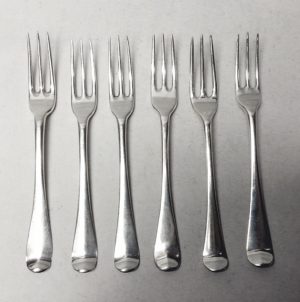
1713 - 1744
8715 Antique George I and II Silver Forks
Sold
A rare matched set of six Hanoverian pattern three pronged forks. Lovely early English style. Each with a matching hand engraved crest to the reverse. One spoon is by David Willaume I, George I reign and made from Britannia* standard silver. The others are from George II reign and made from sterling silver 925 grade. Total weight 372 grams, 11.9 troy ounces. Length 18.5-19 cms (some variation). Mixed dates 1713-1744. Mixed makers, some unidentified.
Table silver of this date was stamped with “up the handle” silver marks which were punched on the thin central part of the handle and it is not unusual that these stamps are distorted or badly struck and difficult to read. -

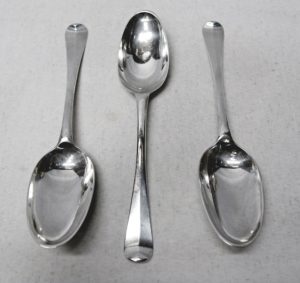
1716
8798 Antique George I Set of 3 Silver Table Spoons
Sold
Three early English silver spoons in the popular Hanoverian rat-tail pattern. Lovely plain style. Britannia standard silver*. Each with a hand engraved monogram to the reverse. Weight 182 grams, 5.8 troy ounces. London 1716. Length 19.5 cms. Maker probably IJ.
-

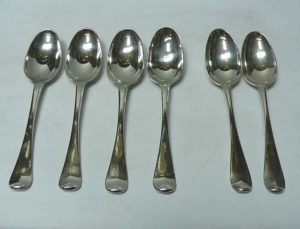
1721
7420 George I Set of 6 Silver Spoons
Sold
A composite set of early English silver spoons in the popular Hanover pattern. Lovely plain style. Britannia standard silver*. Each with a hand engraved crest to the reverse. Weight 446 grams, 14.3 troy ounces. London 1721. 4 spoons by Jane Lambe length 20.15 cms. 2 spoons by Paul Hanet length 19.75 cms. Hanet was one of the principal Huguenot spoon makers of his day.
-

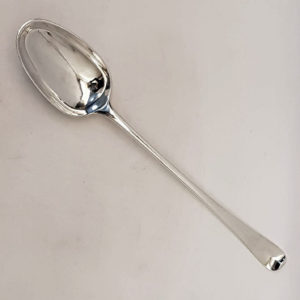
1728
James Savage
9958 George II Antique Silver Serving Spoon
Sold
A massive antique sterling silver spoon in the popular Hanover pattern. Very useful long handled serving spoon. To the reverse of the handle terminal there is an intricate hand engraved armorial. Weight 271 grams, 8.7 troy ounces. Length 39.5cm. Bowl 12 x 7cm. London 1728. Maker James Savage. Sterling silver..
-

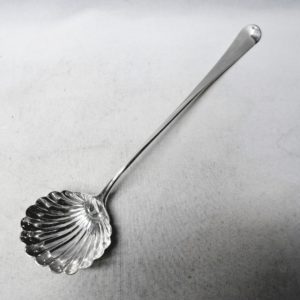
1730
Isaac Callard
8922 George II Silver Ladle
Sold
An elegant antique sterling silver serving ladle with a shell shaped bowl. Excellent plain style. Weight 182 grams, 5.8 troy ounces. Length 36 cms. Width of bowl 8.7 cms. Makers mark only struck 4 times for Isaac Callard, London. Circa 1730
-

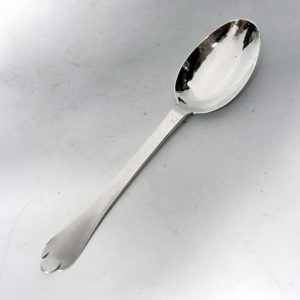
Circa 1730
Thomas David Mauger
9116 Antique Jersey Silver Trefid Spoon
Sold
Channel Islands silver. A good English provincial silver spoon with a trefid terminal and rat-tail bowl. Dessert size. The spoon has a very attractive hand hammered finish. Weight 33 grams, 1 troy ounces. Length 18.5 cm. Bowl 6.75 x 4.25 cm. Makers mark ‘TM’ within a rectangle for Thomas Mauger. Circa 1730.
-

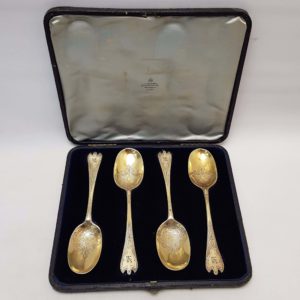
Circa 1730 - 1754
10252 Set of 4 Antique Silver Trefid Spoons
Sold
An excellent quality harlequin set of antique silver serving spoons with shaped handle terminals known as “trefid” form. Bright gilt finish. All with a deeply chased pattern of scroll and foliate designs on a stipple engraved ground, and a hand engraved crest of a lion holding a rose. These spoons were expertly remodelled during the 19th century from plain Hanoverian pattern spoons and fitted into a presentation box. Total weight 216 grams, 6.9 troy ounces. Length 20cm. Bowl 7×4.6cm. Different makers. London c.1730-1754. Sterling silver.
-

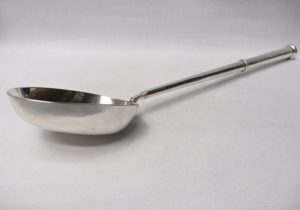
1735
John Blunt II
8205 George II Canon Handle Silver Serving Spoon
Sold
An exceptionally large antique sterling silver hash spoon or serving spoon with a long tubular handle and a large deep bowl. Engraved on the underside of the bowl with initials “ICA”. Spoons of this type were introduced in the late Charles II period and continued until the first part of the 18th century. Weight 214 grams, 6.8 troy ounces. Length 43.5 cms. Bowl 11.7 x 8.4 cms. London 1735. Maker John Blunt II or James Brooker.
-

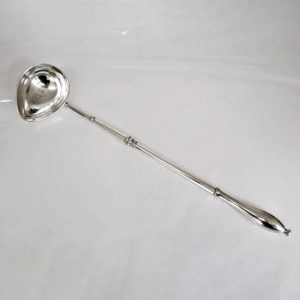
1737
William Justis
9806 George II Silver Cannon Handle Punch Ladle
Sold
This is a fine example of an early English silver cannon handled punch ladle. Engraved on the back of the bowl with contemporary initials M.B. Weight 246 grams, 7.9 troy ounces. Length 36cm. Bowl 6 x 7.3cm. Stamped inside the bowl for London 1737. Maker probably William Justis (mark 3200 in Grimwade’s “London Goldsmiths 1697-1837)”.
-

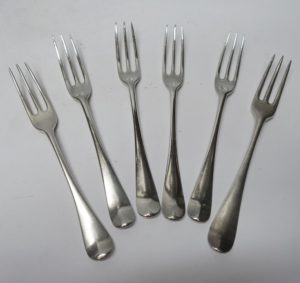
1740 - 1747
9085 Antique George II Silver Forks
Sold
A rare matched set of six Hanoverian pattern three pronged forks. Sterling silver. Lovely early English style. Five with a hand engraved crest to the reverse. Total weight 359 grams, 11.5 troy ounces. Length 18.8–19 cms (some minor variation). 4 forks with mixed dates 1740-1747, 2 forks with unreadable dates. Mixed makers, some unidentified.
Table silver of this date was stamped with “up the handle” silver marks which were punched on the thin central part of the handle and it is not unusual that these stamps are distorted or badly struck and difficult to read. -

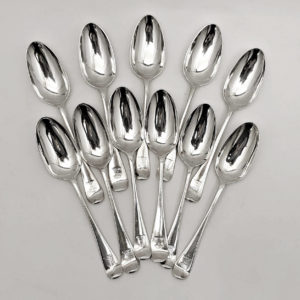
1741 - 1757
7624 George II Set of Silver Serving Spoons
Sold
A composite set of 11 early English sterling silver spoons in the popular Hanover pattern. Lovely plain style. Each with a hand engraved crest of a dog under a tree. Weight 678 grams, 21.8 troy ounces. Length 20 cms approx. Various dates and makers. 4 spoons by Samuel Robey 1741-1746. 3 spoons by Ebenezer Coker 1753-57. 4 spoons are unreadable.
-

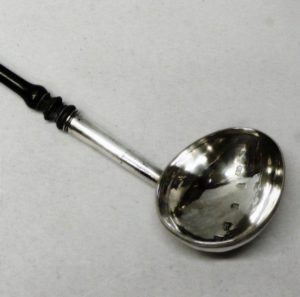
1744
Micon Melun
8623 Antique George II Exeter Silver Ladle
Sold
A rare piece of antique English provincial silver. A Georgian sterling silver punch ladle with an oval shaped bowl and turned wood handle. Length 34 cms. Bowl 7.7 x 5.8 cms. Stamped inside the bowl with a full set of Exeter hallmarks for 1744. Makers mark stylized “MM” for Micon Melun (see Jacksons, mentioned under Falmouth goldsmiths page 317, Pickford edition).
-

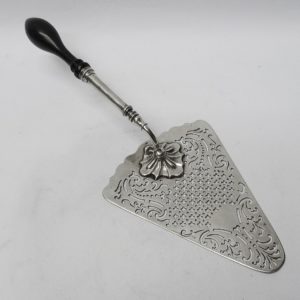
1753
Samuel Courtauld I
9053 Antique Silver Serving Slice
Sold
A rare early antique silver serving slice with an elegant turned hardwood handle. The pierced silver surface is decorated with foliate scrolls and flowers. Hand engraved to the reverse is a large lion crest crowned. Total weight 189 grams, 6 troy ounces. Length 31.5 cms. Width 11.4 cms. Sterling silver. London 1753. Samuel Courtauld I (Grimwade 2489).
-

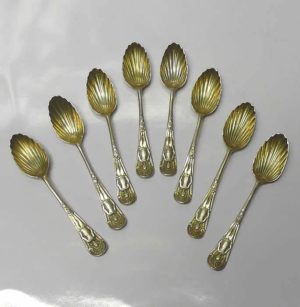
1755
James Jones
6224 Set of 8 Georgian Gilt Silver Teaspoons
Sold
A rare set of antique sterling silver teaspoons with shell bowls. The end of each handle is decorated with an unknown figure. Weight 118 grams, 3.7 troy ounces. Length 11.5 cms. All marked up the handle with maker’s mark and lion passant although not very clear. Probably James Jones (mark registered May 1755).
-

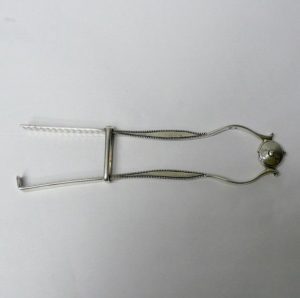
1760
John Hague
8672 Antique Silver Serving Tongs
Sold
A plain style pair of antique sterling silver asparagus tongs (or chop tongs) with a corrugated inside surface to grip the food. Very simple and clever manufacture that would suit either a left or righted handed person. Weight 114 grams, 3.6 troy ounces. Length 21.5 cms. One side is stamped with the makers initials “IH” and the lion mark; the other side is double struck with the makers mark. Maker probably John Hague, circa 1760.
-

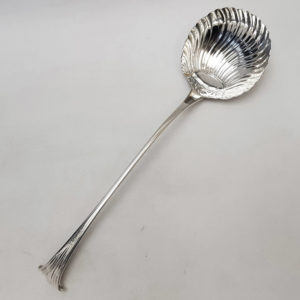
1762
George Baskerville & William Sampel
10275 George III Antique Silver Ladle
Sold
An elegant antique sterling silver serving ladle with a shell shaped bowl. Excellent plain style. Hand engraved decorative initials to the end of the handle. Weight 177 grams, 5.6 troy ounces. Length 34cm. Bowl rim measures 9.5 x 9.2cm. London 1762. Maker initials “GB”. Sterling silver. 18th century.
-

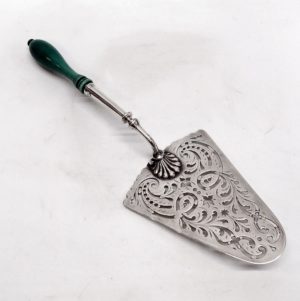
1766
Edward Aldridge
9158 Antique Silver Serving Slice
Sold
A rare early antique silver slice with the pierced silver surface decorated with foliate scrolls and motifs. The elegant turned ivory handle has a green stained finish, very typical of the Georgian period. Hand engraved to the reverse is a double monogram in old fashioned script. Total weight 154 grams, 4.9 troy ounces. Length 31 cm. surface 13×10 cm. Sterling silver. London 1766. Edward Aldridge II.
-

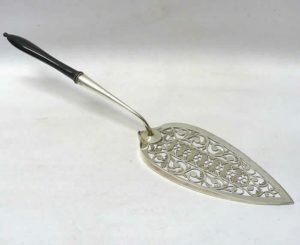
1767 - 1769
7559 Antique German Silver Serving Slice
Sold
A delightful antique silver serving slice with a graceful turned ebony wood handle. The pierced filigree silver surface is decorated with foliate scrolls. Length 38 cms. Marked on the surface close to the handle for Augsburg 1767-9.
-

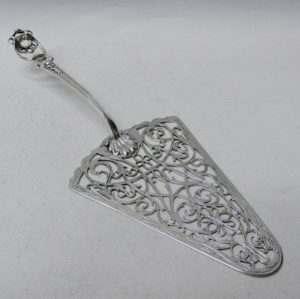
1770
Sarah Buttall
8485 Antique Silver Serving Slice
Sold
A rare early antique silver serving slice with a graceful scrolled handle. The pierced silver surface is decorated with foliate scrolls and line engraving. Weight 135 grams, 4.3 troy ounces. Length 28.25 cms. Width 10.6 cms. Sterling silver. London 1770. Maker Sarah Buttall.
-

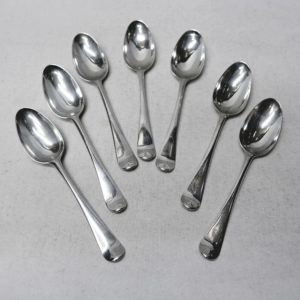
1770
Thomas Evans And George Smith III
8800 Antique George III Silver Spoons
Sold
A set of 7 antique sterling silver spoons in the popular Hanoverian rat-tail pattern. Lovely plain style. Each with a hand engraved monogram to the reverse. Weight 288 grams, 9.2 troy ounces. London 1770. Length 16 cms. Maker Thomas Evans and George Smith.
-

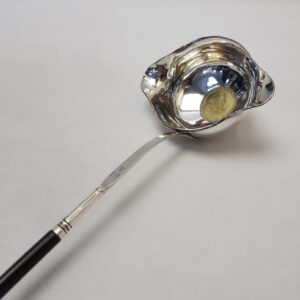
Circa 1770
10296 William and Mary Antique Silver Toddy Ladle
Sold
An antique sterling silver ladle inset with a 22 carat solid gold guinea dated 1691. Elegant, slim design with a twisted horn handle and silver tip. The gold coin bears the heads of King William and Queen Mary of King George to the front, and on the reverse there are armorials for England, Scotland, Wales and Ireland, and the date “1691”. Owner’s initials “T over I*I” are engraved to the front of the handle. Total weight 45 grams, 1.4 troy ounces. Length 32.5cm. Bowl 8.4 x 5.7cm. Unmarked silver, English, circa 1770. Inset 22 carat gold guinea coin, date 1691, diameter 2.5cm. 18th century.
-

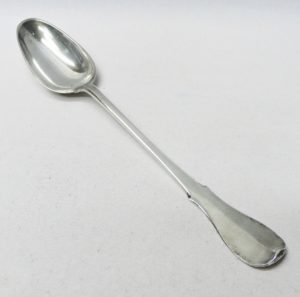
1771
Carolus Benninck
8331 Antique Belgian Silver Spoon
Sold
An early Belgian silver serving spoon of plain form from Brugge. Large size. Heavy gauge silver. Engraved initials to the end of the handle (reverse side). Weight 141 grams, 4.5 troy ounces. Length 29 cms. Fully marked on the back with Belgian silver stamps for Bruges 1771. Maker Carolus Benninck.
-

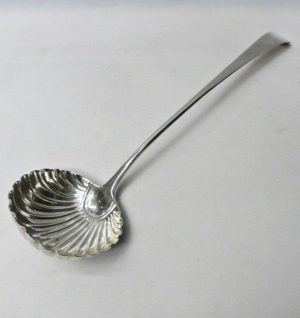
1772
Hester Bateman
8236 George III Silver Ladle by Hester Bateman
Sold
An elegant antique sterling silver serving ladle with a shell shaped bowl. Excellent plain style. Made by the highly sought after Georgian lady silversmith Hester Bateman. Weight 184 grams, 5.9 troy ounces. Length 26 cms. Width of bowl 9.5 cms. London 1772. Maker Hester Bateman.